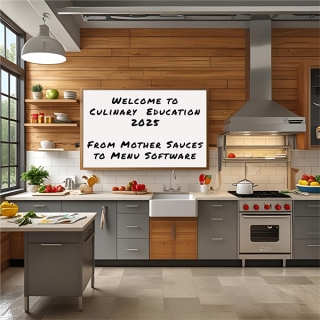
Change Unites Instructors, Students, Foodservice Industry
02 June 2025Sara Johannes discusses how St. Paul College navigates change while uplifting students and providing good value.
By Lisa Parrish, GMC Editor and Sara Johannes, St. Paul College
Feedback & comments: This email address is being protected from spambots. You need JavaScript enabled to view it.
New students will be filling the empty seats left by this month’s graduates. Think about where today’s graduates were in their knowledge a mere two years ago. AI was not commonly used for purchasing or planning. Plant-based dishes were moving from niche to mainstream. The foodservice industry has undergone dramatic changes: Did your program change to match the new needs?
Sara Johannes, department chair and culinary arts instructor at St. Paul College in Minneapolis, diligently works to update her school’s curriculum to more closely match the industry needs for graduating students. She also watches how her new students evolve and differ from students just a few years ago. The courses need to match their needs too. She uses her more than nine years in culinary education and professional experience as an executive corporate chef and work in fine dining establishments to navigate, tweak and lead these changing and challenging elements.
I asked Sara how St. Paul College addresses the shifting new priorities. Her thoughtful answers are below. However, she did mention one requirement that serves as the basis for all change – in the curriculum, with students and in the industry. Change happens because of curiosity and the desire to learn. She said, “It is my favorite thing about food. I will never know everything there is to know about it. Each day in the classroom brings something new to learn for all of us.” That is “all of us” who make up the culinary industry – let the learning begin.
Describe changes you have noted in culinary students over the last five years.
The opportunity cost of education is increasing along with tuition. Being able to afford a quality education is no longer simply about being able to take out loans and pay them off. Students certainly need to find jobs that pay enough to make college affordable. We have found culinary students are now more likely to be juggling family obligations or working multiple jobs. We continue to see more and more non-traditional students – the career-changers, or the older first-time college student. These folks are not looking for the skills that will get them an entry-level line cook position. These folks are looking to get ahead.
What do you think is driving the changes in these culinary students?
The pandemic changed people’s mindsets. When the industry laid off close to 8 million people at the beginning of the pandemic (NRA, 2023) industry folks looked for ways to stay in the business they loved, but be self-reliant. We saw a lot of students come to us because they had dreams of business ownership. We also saw students want to make a difference with food. They were driven by the stories they saw – food insecurity, loss and waste, or just the general lack of hope. They wanted to learn more about the food business to be able to help in charitable ways. We have also seen an uptick in students who choose culinary school to supplement other educational goals. Students come to us to supplement their food science or functional nutrition degrees. There is a high interest in food as medicine.
Can you provide examples of changes your program has made considering the students’ new characteristics?
At Saint Paul College, we have been pushing functional partnerships with industry to keep our curriculum up to date. A focus on new technology has been important. Yes – our students still spend plenty of time on the six-burner with a frying pan. But we are also bringing in corporate chefs from Rational, Irinox, or Carpigiani to demonstrate the latest technology.
We have focused on updating our culinary library to include cookbooks and other resources offering a wide range of experiences and perspectives. The authors are modern and diverse. We have partnered with other departments in the school to offer students the ability to dig into food on a deeper level. For example, we have a section of English composition and U.S. History (both required Minnesota Transfer Curriculum classes for our students) focusing on food and chefs.
We have re-tooled our associate’s degree to focus on leadership and management. We are adding an Entrepreneurship certificate that will provide essential information for those wishing to open a food-based business. We have worked hard to remove barriers for students by drumming up ample scholarship opportunities. We have created an emergency fund for culinary students to help them when times get tough.
We understand students sacrifice a lot to be able to fit coming to school into their lives. We are trying to make it as painless as possible to be here and offer as much practical information as we can in exchange for their time. Education should be useful, empower and uplift. The greatest thing we can give our students is good value for their cost.
Describe changes you witnessed over the last five years in fine dining foodservice.  (Click here to see the2024 World’s Best 50 Restaurants.)
(Click here to see the2024 World’s Best 50 Restaurants.)
We are seeing fine dining fill a global stage. This is exciting for my students. At Saint Paul College, we are incredibly diverse – 65% of our students identify as students of color. While fine dining has been tethered to the European cooking traditions for years, we are now seeing more and more of the best restaurants in the world located in South America, Southeast Asia, Africa, and the Middle East. It is wonderful to be able to show students fine dining inspiration from all corners of the globe.
My students are assigned a chef report every semester – they must report on the career of a fine dining chef that inspires them and talk about the choices they made that influenced their trajectories and careers. Being able to choose a chef to emulate that looks like them and shares their culture or traditions is wonderful. Students are surprised to find these folks, with many of them unaware that some of the best chefs in the world come from their cultures. It is inspiring.
Likewise, we are excited to take inspiration from them. When they bring their background and culture into the kitchen classroom, we all grow. For example, I love to hear about the gardens my Hmong students grow with their families. We hear about how they use the different vegetables, and what’s their favorite way to cook them. We then find ways to bring their influence into menus, combining techniques, and learning from each other. They are so invested in the lesson because we are sharing their story, and the other students love to hear about it. It is my favorite thing about food – I will never know everything there is to know about it. Each day in the classroom brings something new to learn for all of us.
Do you see today’s culinary education aligning with the foodservice changes?
We have been hustling to keep up culinary education in the changing foodservice landscape. Being a part of an organization like CAFÉ is so helpful with this. It is wonderful to be able to commune with fellow foodservice educators, learning from each other. I think this is going to be a bigger part of how education works in general, going forward. Relying on ACFEF competencies, or the backbone textbooks like The Professional Chef will only get you so far. Technology, trends, and industry insights are moving faster than publication. Yes, the textbooks talk about how to plan and cook a banquet for 100. But do they discuss the state-of-the-art labor-saving technologies that are changing every part of how we do that? Sure, the books talk about purchasing and receiving, but can they stay up-to-date on the latest software developments and how AI is changing all of this? Are we teaching students to use these tools effectively? Are we talking to them about to solve business problems with them?
We are usually limited with what we can teach them by time. There are only so many contact hours you can fit into an associate’s degree. At some point, some of the old-school techniques might have to get displaced in lieu of something more vital. We are constantly having these discussions – where do our student’s educational priorities lie? What information can we give them that will help them achieve success after they graduate? If each week is precious, should I spend time on every one of the five Mother Sauces, or on the newest technology that could help them open their own restaurant someday? There are tradeoffs, and I think we should be discussing this more.
About Sara Johannes
Sara Johannes taught at Saint Paul College for over nine years serving as department chair for four years. Sara also received the 2024 Technology Award from RATIONAL USA and the Center for the Advancement of Foodservice Education. Prior to serving as an educator, she worked as an executive chef, running fine dining restaurants for corporate entities like Wolfgang Puck Fine Dining Group, Compass Group, The Ritz Carlton, and OTG Management.

